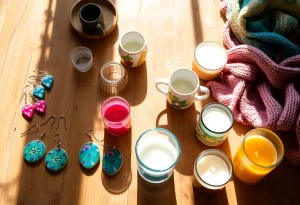Table of Contents
Understanding the Etsy Marketplace
Etsy has grown into a bustling online marketplace where creative entrepreneurs thrive. With over 96 million active buyers worldwide, it’s a goldmine for sellers of unique, handmade, and vintage items. The platform’s success stems from its focus on fostering connections between makers and shoppers who value authenticity.
Let’s look at some key stats that shape the Etsy selling landscape:
| Metric | Value |
|---|---|
| Annual Gross Merchandise Sales | $13.3 billion |
| Active Sellers | 7.5 million |
| Average Buyer Age | 39 years |
Etsy’s top-selling categories often reflect current trends and consumer preferences. Here are some perennial favorites:
- Handmade jewelry
- Personalized gifts
- Home decor
- Art and collectibles
- Craft supplies
Recent trends influencing buyer behavior on Etsy include:
- Sustainability focus
- Support for small businesses
- Desire for unique, customized products
- Interest in vintage and retro items
For new sellers looking to break into the Etsy market, understanding these trends is crucial. It’s also helpful to see how successful sellers approach their Etsy businesses.
This video offers valuable insights for beginners aiming to start selling on Etsy and potentially earn $5,000 per month. It’s packed with practical tips to help you kickstart your Etsy journey.
As you explore profitable business ideas for Etsy, keep in mind that success often comes from finding a niche that aligns with your skills and market demand. Tools like Marketplace Connect can help streamline your operations if you decide to expand to multiple sales channels beyond Etsy.
Top Product Categories for New Etsy Sellers
Starting an Etsy shop can be exciting, but figuring out what to sell can be tricky. Let’s explore some popular categories that tend to do well for beginners:
- Handmade jewelry and accessories: From beaded necklaces to wire-wrapped rings, unique pieces often catch buyers’ eyes.
- Personalized and custom items: Think monogrammed tumblers or custom pet portraits – people love one-of-a-kind stuff.
- Digital products and printables: Planners, wall art, and invitation templates are low-cost to produce and easy to deliver.
- Home decor and vintage finds: Handcrafted throw pillows or curated antique collections can spruce up any space.
- Art and collectibles: Original paintings, sculptures, or limited edition prints appeal to art enthusiasts.
The key is finding a niche you’re passionate about. When you love what you make, it shows in your work and your shop’s vibe.
This video offers some real talk about starting an Etsy shop. It’s worth a watch if you’re on the fence about jumping in.
Crafting Your Unique Etsy Business Idea
Now that we’ve covered some popular categories, let’s dive into how you can develop your own standout shop concept:
- Identify your skills and passions
- Research market demand and competition
- Define your target audience
- Create a unique value proposition
- Develop a cohesive product line
Start by making a list of things you’re good at and enjoy doing. Then, hop on Etsy and see what’s already out there. Look for gaps in the market where your skills could shine.
Next, think about who would love your products. Are they eco-conscious millennials? Busy moms? Vintage collectors? Understanding your audience helps shape your entire shop strategy.
- What makes your products special?
- How can you solve a problem for your customers?
- What unique twist can you add to common items?
Answering these questions will help you craft a compelling value proposition. Remember, standing out on Etsy isn’t just about what you sell, but how you present it.
Setting Up for Success on Etsy
Once you’ve nailed down your business idea, it’s time to set up shop. Here are some key areas to focus on:
| Area | Why It Matters | Quick Tip |
|---|---|---|
| Shop Profile | First impression for buyers | Use all available sections, be authentic |
| Product Listings | How buyers find you | Use relevant keywords, clear descriptions |
| Pricing | Affects profitability | Factor in all costs, including your time |
| Photography | Showcases your products | Use natural light, multiple angles |
| Customer Service | Builds reputation | Respond promptly, be helpful |
Optimizing these elements can give your shop a solid foundation. But don’t forget about the backend stuff too. Managing orders and inventory across multiple channels can get messy fast.
That’s where tools like Marketplace Connect come in handy. It syncs your Etsy shop with other platforms like Shopify, keeping everything organized without the headache. You can check it out here if you’re curious.
Remember, success on Etsy doesn’t happen overnight. It takes time, patience, and a willingness to learn and adapt. But with the right approach and tools, you can turn your creative passion into a thriving online business.
Overcoming Common Challenges for New Etsy Sellers
Starting an Etsy business can be exciting, but it comes with its share of hurdles. Let’s break down some key challenges and how to tackle them:
- Inventory management
- Fulfillment logistics
- Standing out in a crowded marketplace
- Balancing quality and production speed
- Scaling as demand grows
Managing inventory and fulfillment is often a major pain point for new sellers. As orders start rolling in, keeping track of stock levels and shipping out products promptly can quickly become overwhelming. This is where automation tools can be a game-changer. For example, Marketplace Connect helps sellers sync inventory across multiple channels, reducing the risk of overselling and streamlining order management.
Competition on Etsy is fierce, with millions of active sellers vying for attention. To stand out, focus on these key areas:
- Unique product offerings
- High-quality product photos
- Detailed, keyword-rich descriptions
- Excellent customer service
Balancing quality and production speed is crucial as your business grows. While maintaining product quality is non-negotiable, finding ways to streamline your production process can help you meet increasing demand without burning out. Consider investing in tools or equipment that can speed up your workflow without compromising on quality.
As your Etsy shop gains traction, scaling becomes the next big challenge. This might involve:
- Hiring help or outsourcing certain tasks
- Expanding your product line strategically
- Implementing more robust inventory and order management systems
Remember, growing pains are a sign of success. By anticipating these challenges and preparing for them, you’ll be better equipped to turn your Etsy side hustle into a thriving business. Tools like Marketplace Connect can play a crucial role in this transition, helping you manage multiple sales channels efficiently as you expand beyond Etsy.
Your Etsy Success Roadmap
Starting an Etsy shop can be both exciting and challenging. We’ve covered some great business ideas to get you going, from handmade jewelry to digital downloads. The key is finding what works for you and your skills.
Remember, success on Etsy doesn’t happen overnight. It takes time, effort, and a willingness to learn. Keep an eye on trends, listen to your customers, and be ready to adapt your products and strategies.
As you grow your Etsy business, you might find yourself juggling multiple sales channels. That’s where tools like Marketplace Connect can help streamline your operations, letting you focus on creating and selling.
Ready to take the plunge? With these ideas and tips in mind, you’re well-equipped to start your Etsy journey. Who knows? Your shop could be the next big thing on Etsy. But before you dive in, let’s address some common questions new sellers often have.
Frequently Asked Questions
How much does it cost to start an Etsy shop?
Starting an Etsy shop is relatively affordable. It’s free to open a shop, but you’ll pay a $0.20 listing fee per item. When you make a sale, Etsy takes a 6.5% transaction fee plus payment processing fees. Budget for material costs and shipping supplies too. Many sellers start with less than $100 in initial investment.
What are the best-selling items on Etsy?
Popular items on Etsy include:
- Handmade jewelry
- Personalized gifts
- Home decor
- Art prints
- Vintage items
The key is finding a niche that matches your skills and passion. Unique, high-quality products tend to perform well.
How long does it take to make a profit on Etsy?
The timeline to profitability varies widely. Some sellers see profits within a few months, while others may take a year or more. Success depends on factors like product quality, pricing strategy, and marketing efforts. Focus on creating great products and building your brand presence for the best results.
Can I sell on Etsy if I’m not crafty?
Absolutely! While Etsy is known for handmade items, you can also sell vintage goods (20+ years old) or craft supplies. Digital products like printables, patterns, or graphic designs are popular too. There’s room for various business ideas that don’t require traditional crafting skills.
How can I manage orders across multiple platforms?
Managing orders from different marketplaces can be challenging. Tools like Marketplace Connect can help by syncing orders and inventory across platforms like Etsy, Amazon, and your own Shopify store. This automation saves time and reduces errors, letting you focus on growing your business.
What are some tips for Etsy SEO?
To improve your Etsy shop’s visibility:
- Use relevant, specific keywords in titles and tags
- Write detailed, informative product descriptions
- Update your shop regularly with new items
- Encourage customer reviews
- Use high-quality, clear product photos
Remember, Etsy’s algorithm favors shops with complete information and positive customer interactions.





